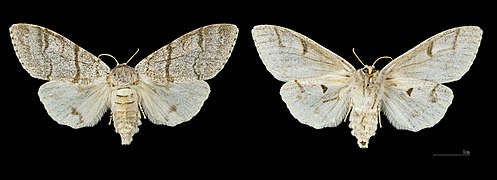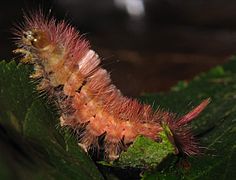| Pale tussock | |
|---|---|

| |
| Scientific classification | |
| Domain: | Eukaryota |
| Kingdom: | Animalia |
| Phylum: | Arthropoda |
| Class: | Insecta |
| Order: | Lepidoptera |
| Superfamily: | Noctuoidea |
| Family: | Erebidae |
| Genus: | Calliteara |
| Species: | C. pudibunda |
| Binomial name | |
| Calliteara pudibunda (Linnaeus, 1758) | |
| Synonyms | |
| |
Calliteara pudibunda, the pale tussock, is a moth of the family Erebidae. The Dutch common name for the moth (Meriansborstel) comes from the butterfly and insect painter Maria Sibylla Merian. The species was first described by Carl Linnaeus in his 1758 10th edition of Systema Naturae. It is found in Asia and Europe.
Technical description and variation
For a key to the terms used, see Glossary of entomology terms.Calliteara pudibunda is a pest of European beech forests (Fagus sylvatica). The mix of tree species impacts the moths; they react very sensitively to the occurrence of a small portion of spruce trees within beech stands.
The wingspan is 40–60 mm. Female: Forewing greyish white dusted with dark, and bearing dark wavy transverse lines edged with pure white on the inner side. Hindwing white with indication of a dark submarginal band. Male: Forewing olive grey with black median area and darker indistinct slightly wavy transverse lines in the marginal and basal areas. Hindwing greyish yellow, with a transverse band which is slightly more distinct than in the female, and sometimes forms an elbowed anal. Form juglandis Hübner is divergent in the male, being distinguished by a greyish-white head and thorax (in typical specimens this is dark brown or only slightly lighter), as well as by a whitish basal area of the forewing. The median area is grey with blackish discocellular spot and marginal lines; hindwing with distinct dark submarginal band and discocellular spot. In the female the submarginal band of the hindwing is also more distinct than in typical specimens. Aberration concolor Staudinger has dark grey forewings, unicolorous or with only traces of transverse lines.

Biology
The moth flies from April to June.
Egg light yellowish brown with dark median spot. Larva usually light lemon yellow, but sometimes brownish yellow, violet or blackish grey, with deep black segmental incisions, lighter dorsal brushes and red or brown pencil on the 11th segment. The larvae feed on oak, beech, willow, birch, Prunus and Crataegus species. It was formerly a pest on hop plants in the English home counties, where it was known as the hop dog.
Distribution
It is found in Europe, Anatolia, Caucasus, western Siberia, eastern Transbaikalia and the Amur basin in south-eastern Russia, Korea, China and northern Vietnam.
Gallery
-
 Imago (showing hairy legs)
Imago (showing hairy legs)
-
 Mounted male
Mounted male
-
 Mounted female
Mounted female
-
 Eggs
Eggs
-
 Caterpillar (yellow form)
Caterpillar (yellow form)
-
 Caterpillar (brown form)
Caterpillar (brown form)
References
- Seitz, A. Ed. Die Großschmetterlinge der Erde, Verlag Alfred Kernen, Stuttgart Band 2: Abt. 1, Die Großschmetterlinge des palaearktischen Faunengebietes, Die palaearktischen Spinner und Schwärmer, 1912-1913.
- Skinner, Bernard; Wilson, David (2009). Colour Identification Guide to the Moths of the British Isles. Stenstrup, Denmark: Brill. p. 96. ISBN 9789004261020.
External links
- Kimber, Ian. "72.015 BF2028 Pale Tussock Calliteara pudibunda (Linnaeus, 1758)". UKMoths. Retrieved 14 May 2020.
- Savela, Markku (8 January 2019). "Calliteara pudibunda (Linnaeus, 1758)". Lepidoptera and Some Other Life Forms. Retrieved 14 May 2020.
- "10387 Calliteara pudibunda (Linnaeus, 1758) - Buchen-Streckfuß, Rotschwanz". Lepiforum e. V. Retrieved 14 May 2020. (in German)
| Taxon identifiers | |
|---|---|
| Calliteara pudibunda |
|